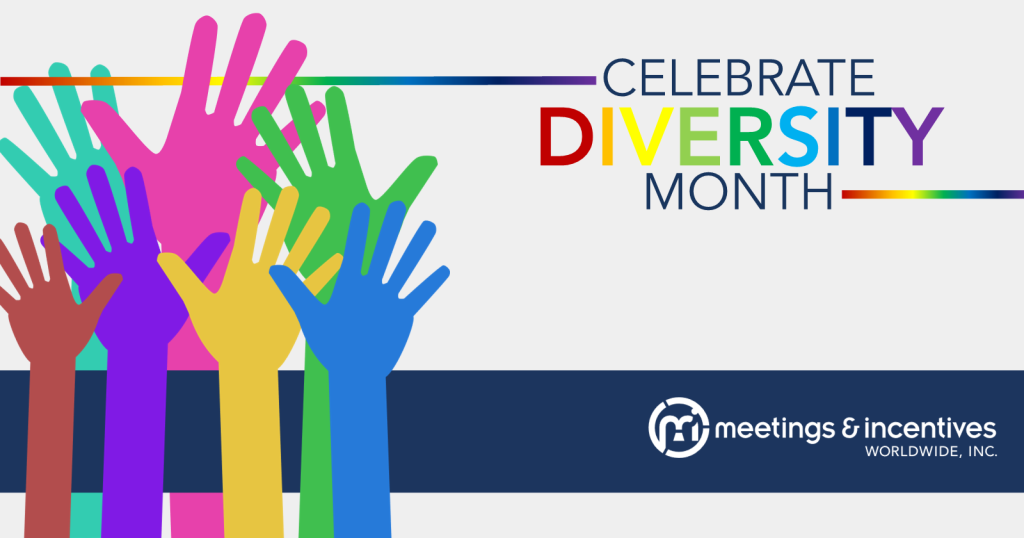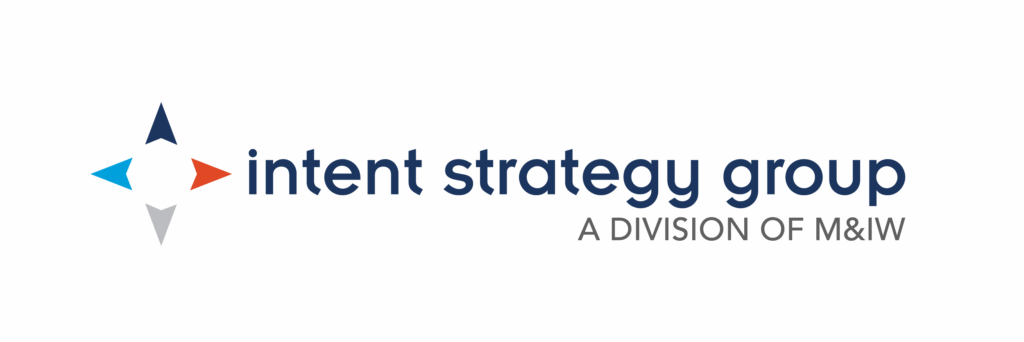DEIB Discussions: How to Improve Diversity and Inclusion at Meetings and Events
In honor of Celebrate Diversity Month, held every April in the US, we’re exploring ways to increase diversity and inclusion at events. Diversity is important in the workplace, and in our industry, the workplace extends to the meetings and events we plan and execute. A lack of diversity at events means valuable points of view are being missed, and attendees may not feel as welcome.
The good news is that according to a recent study by MPI, 56% of event professionals have written diversity and inclusion policies in place.1 While these policies, like M&IW’s DEIB mission statement, are a great place to start, actions speak louder than words. Before we explore the actionable ways to make events more diverse, let’s go back to the basics of what diversity is.

Defining Diversity
As defined by M&IW’s DEIB team, diversity is the appreciation and prioritization of people of different backgrounds and identities, including but not limited to race, religion, gender identity, sexual orientation, and ability.
Related concepts include:
- Equity: The acknowledgement that different people may need different levels of support to achieve their goals and the act of intentionally providing that support.
- Inclusion: The culture or environment created to allow diversity to thrive.
- Belonging: The feeling of security within a group that stems from proactive efforts to include someone.
How to Make Events More Diverse
Incorporating greater diversity into meetings and events should not be an afterthought. Rather, it should be an integral part of planning from the beginning. As with sustainability efforts, diverse initiatives may come at a higher price point, but that shouldn’t be a deterrent. Anticipate those higher costs when creating the event budget and identify areas that can be produced at a lower price point to allow for greater diversity elsewhere.
These actionable recommendations for how to encourage greater diversity and inclusion are not a to-do list but a starting point. These considerations can and should be improved and expanded upon for every event.
Build a Diverse Event Planning and Management Team
One way to ensure diversity is considered throughout the planning process is to have a diverse team in place. They will ensure DEIB is considered at every step. Having a diverse team will also encourage diverse partners and attendees, so be sure to highlight your team with a dedicated page on your event website.
If you’re not sure whether your team is diverse, ask yourself, “Who is represented? Who is missing?” Consider all backgrounds and identities, including but not limited to race, religion, gender identity, sexual orientation, and ability.
Hire Diverse Speakers
Just as you should ask yourself who is represented in your planning and management teams, you should also ask that of your presenters. It is important because attendees want to see themselves represented and know their voices are heard and considered. While no one should be asked to speak for all members of a particular race, religion, etc., diverse presenters make the content more relatable and represent a broader point a view overall.
Once diverse speakers are confirmed, don’t hide them from the audience. List them on the website and share them on social media as you would with any other speaker. The goal is not to brag about how diverse the event is but rather to highlight their accomplishments and credentials along with the knowledge and expertise they will bring to the event.
Partner with Diverse Suppliers and Venues
Diverse suppliers are organizations that are at least 51% owned or operated by a traditionally underrepresented or underserved group and can include Women’s Business Enterprise-certified organizations like M&IW and Minority Business Enterprise-certified companies. Establishing a supplier diversity program can help maximize partnerships with diverse suppliers and reap the many benefits.
Even if the supplier partner doesn’t have diverse ownership or management, there are other ways to ensure they serve diverse audiences. For example, venues can now receive a Certified Autism Center designation.
When searching for diverse suppliers and venues and deciding who to work with, questions to as include:2
- Does the site visit reveal adequate accessibility to the destination and the venue?
- Is your caterer willing to work with diet restrictions and faith-based dietary needs?
- Is your venue willing to take steps to ensure every attendee has equal access to the event?
- How can your event badge supplier work with you to create credentials that reflect inclusivity?
- Has the staff received training on understanding and work with attendees with sensory and other diverse needs?
- Does the venue allow service animals and, if so, are there any restrictions on the type or size of animal?
Source Inclusive Destinations
Consider not just the event venue but the destination as a whole. Everyone should feel welcome travelling to the event, so source destinations that are demonstrated to be safe and inclusive for all people. Actively choosing not to host or spend money in a city, state, or country that is proven to be exclusionary can send a powerful message and impact your organization’s reputation; however, the opposite is also true, so source wisely. If your event must take place in an exclusionary destination, communicate the steps you’re taking to ensure your event is a safe space.
If you’re not sure how inclusive a location is, ask the local Convention & Visitors Bureau (CVB) or destination management company. They should not shy away from the question if it’s truly a diverse destination. In fact, many CVBs go out of their way to prove just how welcome diverse communities are.3
Provide Special Accommodations
Again, consider diversity early on so you’re prepared for anything. Attendees should not feel excluded from events because their needs can’t be met. Examples of special accommodations include:
- Designate a prayer room for Salah, the Islamic daily prayers, and communicate its location so anyone who wishes to pray knows where to go.
- Plan gluten free, vegan, and kosher menu options and share menus in advance so attendees can notify you of any concerns or come prepared with food that is safe for them.
- Design the room set up so there’s enough space for people with mobility aids or service animals to maneuver.
- Provide a sign language interpreter for all sessions and reserve seating at the front for those who are hard of hearing or have limited vision.
- For virtual events or for any videos played during in-person events, provide closed captions.
- When selecting event dates, avoid major religious holidays. If that’s not possible, provide appropriate accommodations, such as meatless meal options on Fridays during Lent or meals after sunset during Ramadan.
Use Inclusive Language
As defined by the Linguistic Society of America, inclusive language acknowledges diversity, conveys respect to all people, is sensitive to differences, and promotes equal opportunities.4 While many events now have policies denouncing racist or sexist language, we can and should go further. Foster LGBTQ+ inclusivity by replacing gendered language like “ladies and gentlemen” with gender neutral alternatives like “everyone.” People-first language, such “people with disabilities” instead of “disabled people” or “handicapped people,” should also be used to be more inclusive of all ability levels.
Also consider the stigma or context around language. “Hard of hearing” is preferred over “hearing impaired” because impaired has a negative connotation, for example. Similarly, guru is a title of high esteem in the Buddhist and Hindu religions, so it should not be used in place of expert.
Incorporate Diverse Content
Beyond just the language used, the event content itself should be diverse and should relate to and impact all audiences. Diverse content includes select breakout sessions or a keynote presentation. Alternatively, the entire event can be about diversity within an industry. While created for use by teachers, the Universal Design for Learning can be used as a starting point for event content and agendas as it establishes a set of principles for designing curriculum to serve all learners, regardless of ability, age, gender, or cultural or linguistic background.
While it is important to have diverse speakers representing diverse content—for example, male panelists should not speak about women’s impacts within an industry—do not only hire these speakers for this content. They have so much more knowledge to offer.
Set Diversity Goals
Setting goals for diversity and inclusion not only helps keep those considerations top of mind but also makes it easy to stay accountable. Track your progress during the planning lifecycle and measure your impact after the event. Include questions related to your goals on the post-event survey to get the attendees’ perspectives. If all goals are met, it’s time to raise the bar for the next event.
Next Steps
If you’re ready to plan events with greater diversity but don’t know where to start, you’ve come to the right place! As a women-owned company, M&IW has always championed diversity and inclusion within our organization and the events we manage. Our meetings, events, and incentives experts are ready to support your efforts every step of the way. Contact us to get started.
Already an M&IW customer? Contact your Customer Success Manager to learn more.
Contributor

Kaycee McFalls
Digital Producer, Production & Technology
DEIB Team Member
Sources
1 Meeting Professionals International, 2018
2 pc/nametag, 2022
3 Skift Meetings, 2022
4 Linguistic Society of America


